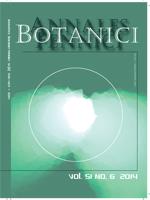Saara Velmala, Leena Myllys, Trevor Goward, Håkon Holien, Pekka Halonen
Annales Botanici Fennici 51 (6), 345-371, (1 December 2014) https://doi.org/10.5735/085.051.0601
Ninety-seven ingroup specimens of Bryoria section Implexae (Parmeliaceae, Lecanoromycetes) were studied using molecular, chemical, morphological and geographic characters. The molecular data included nuclear ribosomal markers (ITS, IGS) and the partial glyceraldehyde-3-phosphate dehydrogenase (GAPDH) gene. In addition to parsimony analyses, a haplotype network was constructed. Phylogenetic analyses strongly supported the monophyly of the section Implexae. The specimens were grouped into two monophyletic clades. Clade 1 encompassed all esorediate material from North America, whereas Clade 2 included both sorediate North American material and all European material. Relationships at the species level, however, remained unresolved, except in the case of North American B. implexa chemotype 1 and European B. capillaris. Nevertheless a number of species in each clade can be recognized using traditional morphological, chemical and ecological characters: Bryoria friabilis, B. inactiva sp. nova, B. kockiana sp. nova (supported also by phylogeny), B. pikei and B. pseudofuscescens in Clade 1, and B. capillaris, B. fuscescens, B. implexa, B. kuemmerleana, and B. vrangiana in Clade 2. In addition, North American B. capillaris is proposed for inclusion in B. pikei, while B. chalybeiformis, B. lanestris and B. subcana are used as synonyms of B. fuscescens.

